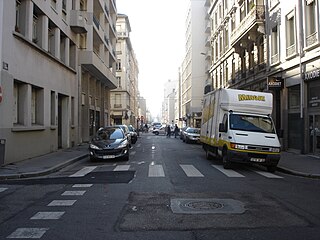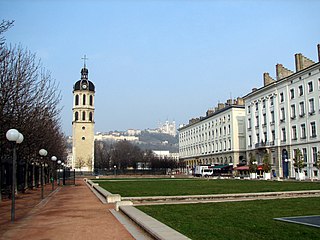
The Place Antonin-Poncet is a square located in the Bellecour quarter, near the Place Bellecour, in the 2nd arrondissement of Lyon, France. It is served by the metro station Bellecour of the lines A and D, and by many buses (10-12-14-15-29-30-35-53-58-88-99). The square belongs to the zone classified as World Heritage Site by UNESCO.

The Rue des Marronniers is a street located in the Bellecour quarter, in the 2nd arrondissement of Lyon. It is a small paved pedestrian street famous for its many bouchons. It is served by the metro station Bellecour and many buses. The street belongs to a zone classified as a World Heritage Site by UNESCO.

The Cours Charlemagne is a large central street located in the Perrache quarter, in the 2nd arrondissement of Lyon. This street is dedicated to Charlemagne, who came several times to Lyon. In addition, the bishop Leidrade represented the emperor in the city and by his great work of reconstruction. The Cours Charlemagne begins Place des Archives, just at the south of the vaults of the interchange of Perrache. It ends on the Quai Perrache, which overlooks the Pont Pasteur.
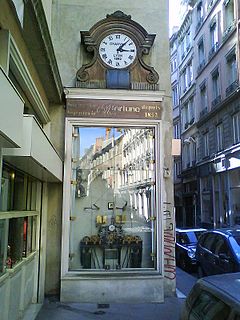
The Rue de la Poulaillerie is a street located in the 2nd arrondissement of Lyon, France. It was first named rue Vaudran, and also rue Maudite in reference to Peter Waldo, who founded what was considered a heresy at the time, the street received its current name from the fact that people exchanged poultry until 1835, when part of this trade emigrated to the covered market of La Martinière.

The Rue de Brest is a street located in the 2nd arrondissement of Lyon. This is one of the main shopping and tourist streets of the city center, parallel to the rue Édouard-Herriot. It begins in the wake of the rue Paul Chenavard and ends with the Place des Jacobins.
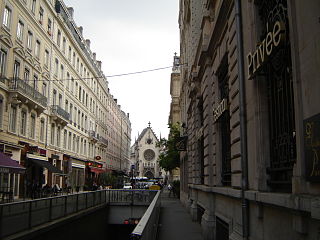
The Rue de la Bourse is a street located mainly in the 2nd arrondissement of Lyon, and also in the 1st arrondissement. It starts on the Place des Cordeliers, in the 2nd arrondissement, in front of the Église Saint-Bonaventure, and ends at right angles to the Rue du Bât-d'Argent, beyond which it is extended by the Rue du Garet.
The Rue Édouard-Herriot is one of the most important shopping streets of the Presqu'île in Lyon. It links the two most famous places of the city, the Place Bellecour (south) and the Place des Terreaux (north). Its northern part is located in the 1st arrondissement of Lyon, but the main part of the street is in the 2nd arrondissement. In its southern part, the street passes through the Place des Jacobins. It belongs to the zone classified as World Heritage Site by UNESCO.

The Rue du Bât-d'Argent is an old street which crosses perpendicularly a part of the Presqu'île quarter in the 1st arrondissement of Lyon. It begins at the rue Édouard-Herriot, in continuation of the rue du Plâtre, crosses the rue de la République and the rue du Garet, and ends on the Quai Jean Moulin. The street is famous for its college, the Collège-lycée Ampère.
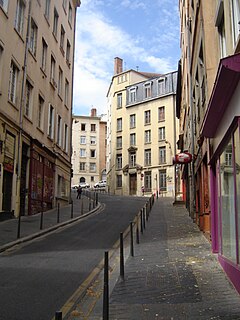
The Montée des Carmélites is one of the oldest streets of Lyon, dating from Roman times, located in the 1st arrondissement of Lyon. It connects the Saint-Vincent quarter to the Plateau de la Croix-Rousse. It is situated between the rue de la Tourette and the rue Ray Fernand, and ends at the intersection of the rue Burdeau, rue du Jardin des Plantes and rue de l'Annonciade.

The Rue Lanterne is one of the oldest streets of Lyon created the Middle Ages, which is located in the 1st arrondissement of Lyon. It begins after the rue d'Algérie and ends against a facade of the rue Longue.

The Avenue du Maréchal de Saxe is a broad avenue located in the 3rd and the 6th arrondissements of Lyon. It was named after Maurice de Saxe, Marshal of France.
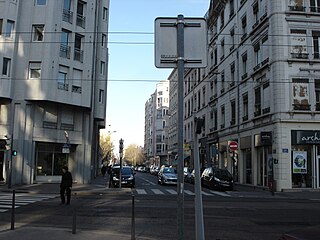
The Rue Duguesclin is a long street in Lyon crossing directly wholly the 6th and the 3rd arrondissement, and ends in the 7th arrondissement. This 2,800-meter street starts at the Boulevard des Belges and ends on the rue Rachais. The Lyon inhabitants and the telephone directory usually write the street name in a sole word (Duguesclin) and the cartographers do it in two words.

The Rue de l'Arbre-Sec is an old street located in the 1st arrondissement of Lyon, near the Place des Terreaux and the Opera Nouvel. It starts perpendicular to the rue Édouard-Herriot and ends with the Quai Jean Moulin crossing the rue de la République. The name dates from the 14th century and was probably chosen because of a dry tree that could be seen in this street and of an inn sign.
The Rue Dumenge is a street located in the 4th arrondissement of Lyon, in the quarter of La Croix-Rousse. It begins on the rue du Mail, crosses the rue du Pavillon and the rue de Belfort and ends on the rue Dumont-d'Urville. The street is served by a metro station of the line C and a velo'v station.

The Boulevard des Belges is a wide and posh avenue located in Les Brotteaux quarter, in the 6th arrondissement of Lyon. It begins with the Quai de Grande Bretagne, runs along the southern part of the Parc de la Tête d'Or until the Avenue Verguin and ends on the Place Jules Ferry, in front of the Gare des Brotteaux. The boulevard is lined with plane trees and is served by two velo'v stations and the line B of the metro.

The Rue du Bœuf is a 188-metre cobbled pedestrian street of the Vieux Lyon quarter, located in the 5th arrondissement of Lyon. Very representative of the Renaissance architecture of the neighborhood, it is lined only with old houses from the 16th or 17th century. The street connects the rue de Gadagne which it continues after the Place du Petit Collège and the intersection of the rue du Chemin Neuf, the rue de la Bombarde and the rue Tramassac which prolongs it. The street belongs to the zone classified as World Heritage Site by UNESCO.

The Place Benoît-Crépu is a stone-paved square, located in Saint-Georges quarter, on the banks of the Saône, in the 5th arrondissement of Lyon. It has fountains with dolphin heads, many benches and trees and a playground. The place belongs to the area classified as World Heritage Site by UNESCO.

The Rue des Capucins is a street located in the 1st arrondissement of Lyon, between the slopes of La Croix-Rousse and the Place des Terreaux. Straight but slightly inclined, it continues the rue du Sergent Blandan, begins with the Place des Capucins and ends on the Place Croix-Paquet. It is parallel to the rue René Laynaud. The street belongs to the zone classified World Heritage Site by UNESCO.





